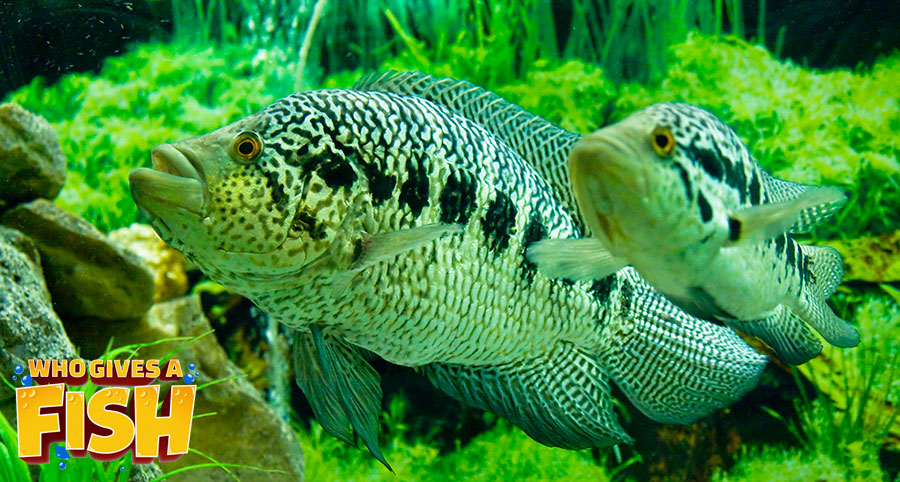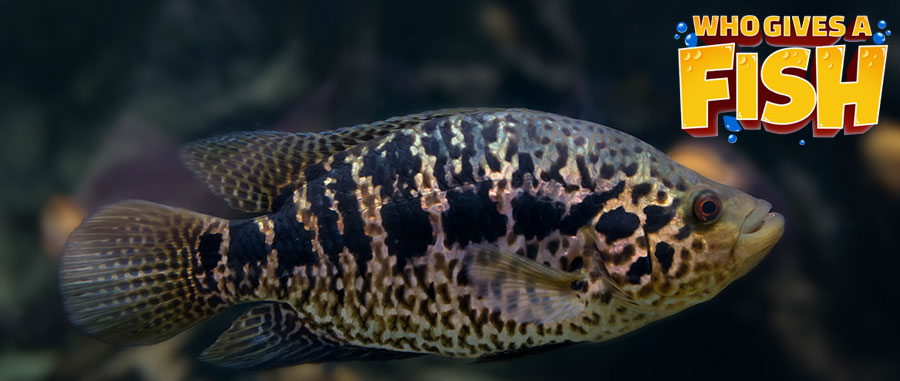Jaguar Cichlid
The Jaguar Cichlid, Parachromis managuensis, is considered an experienced aquarists fish as it is hard to keep. While water parameters are not difficult to maintain for this species, their aggression is. The Jaguar Cichlid not only takes its name from its coloration and patterns once it has fully developed, but also from its ferocious aggression and predatory nature towards other small fish, including its own kind.
- Experience Level: Advanced
- Hardiness: Moderate hardiness
- Minimum Tank Size: 120 gal (450 L)
- Maximum Size: 25 in. (63.5 cm)
- Temperament: Aggressive – Predator
- Temperature: 75 – 82° F (23.9 – 27.8° C)
- pH Range: 7.0 – 8.7
- Water Hardness: 10 – 15 dGH
- Diet: Carnivore
Table of Contents
Introduction
Aquarium Setup
Difficulty
Feeding
Breeding and Social
Wild specimens have been found to grow to 24 inches, which is an extremely big fish for the standard aquarium. In captivity, however, the largest specimens have been recorded at around 15 inches, although this is still a very large fish for most aquariums.
The Jaguar Cichlid is best kept in a very large tank, with proper aggression mitigation. Most smaller fish will become food as this Cichlid is a predator and will even attack and kill its own kind.
Like many Cichlids, this one will dig and burrow and will cause you all kinds of problems with rockwork and plants if you do not secure these. The Jaguar Cichlid can also jump out of your tank if given a chance, so ensure that you have proper safeguards in place so they can’t make it out.
Aquarium Setup
This large Cichlid needs a minimum of 120 gallons. This big size is needed primarily to assist in aggression mitigation, but also to provide enough water for the big bioload they produce.
You will need plenty of good hiding places and dark areas. Their natural habitats water clarity is poor and they are more suited to cloudy/murky waters, however this is not ideal for most display tanks. Ensure to provide enough well secured vegetation and structure for shelter.
Water flow is important and they appreciate moderate to strong flow in most of the tank. Calmer areas for feeding are also advised and make for cleaning waste much easier.
Like most fish, keeping the water temperature on the lower end of the recommended scale will help curb their aggression.
Jaguar Cichlid Aquarium Guide
- Minimum Tank Size: 120 gal (450 L)
- pH Range: 7 – 8.7
- Water Hardness: 10 – 15 dGH
- Temperature: 72 – 82° F (21.1 – 27.8° C)
- Lighting: Low to Moderate
- Substrate: Gravel
- Brackish: No
- Water Flow: Moderate – Strong
- Tank Region: All regions
Difficulty
As mentioned above, the main concerns and difficulties encountered with this fish is the aggression. Strong filtration is required by using multiple canister filters or a sump as they produce a large bioload.
Feeding
In the wild, the Jaguar Cichlid is a predator and will usually feed on smaller fish and other live organisms. In captivity they will take smaller fish, insects such as crickets and worms and also enjoy chopped up fresh fish and crustaceans. A large feeding once per day is generally recommended as this helps with water quality and their overall health.
Animals product that is high in fat should not be fed to these Cichlids as it can cause digestive issues that will lead to disease and eventually death.
Jaguar Cichlid Feeding Guide
- Diet: Carnivore
- Frequency: Once per day. Fast for one day every 7-9 days.
- Pellet Foods: Cichlid specific pellet food.
- Flake Foods: Only for young fish. Cichlid specific flake food.
- Live Foods: Yes, smaller fish such as goldfish and guppies, crickets and worms etc.
Breeding
Males will lose their ‘bar’ pattern as they age and are generally much larger than the females.
While these Cichlids have been bred in captivity are are easy to spawn, it is not recommended unless you are an advanced aquarist. Aggression levels can be exceptionally high and you will require big tanks.
You can purchase breeding pairs, however, purchasing 5-6 juveniles should produce a breeding pair once they develop. New female additions to an already established tank will be attacked by males and sometimes killed. Raising your temperature to around 81-82° F and doing larger than usual water changes, more often can trigger spawning.
Both male and female will find a suitable area to dig out and the female will lay her eggs and the male will fertilize them. The male will become extremely aggressive at this time and will attack anything and everything (even the female sometimes) when defending the eggs.
The eggs should hatch within 3 to 4 days provided you keep the temperature raised as mentioned earlier. It is normal if the female moves the eggs to another borrow or dug out site.
The eggs and newly hatched fry are easy targets for Plecos and other fish that can sneak in during the dark of night, and for maximum survivability, it is best to remove and raise the fry in a separate tank.
Social
This Cichlid should not be kept in a community tank. The Jaguar Cichlid is one of the most aggressive and predatory Cichlids and as such, should be well thought out before purchasing.
It can live in the same tank as other large Central and South American Cichlids, but will require a very large tank to help mitigate aggression. Breeding pairs should be removed from a tank with any other fish or vice versa. When they are breeding, all other fish are in danger and fish such as plecos will steal the eggs at night.



